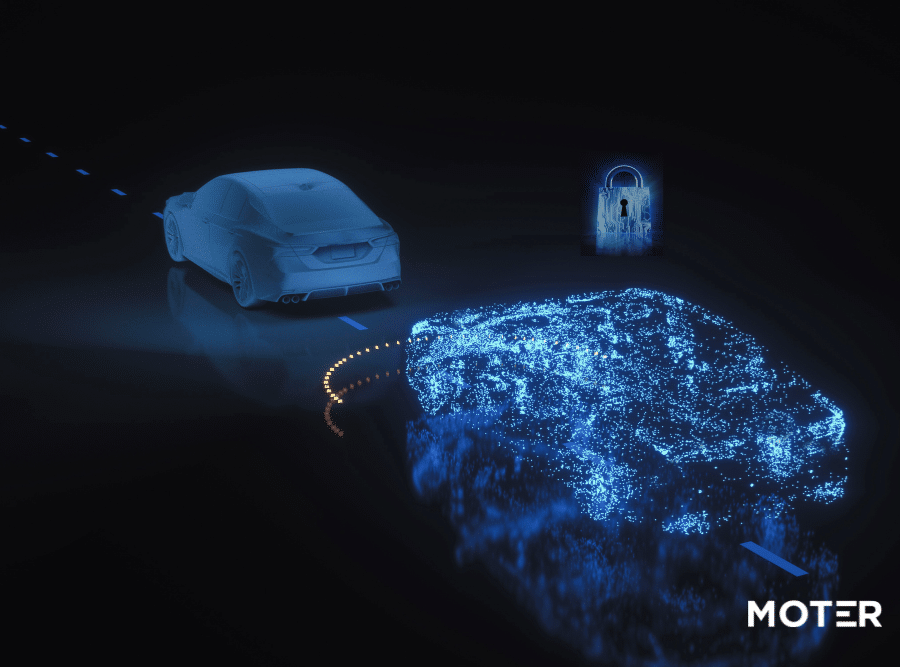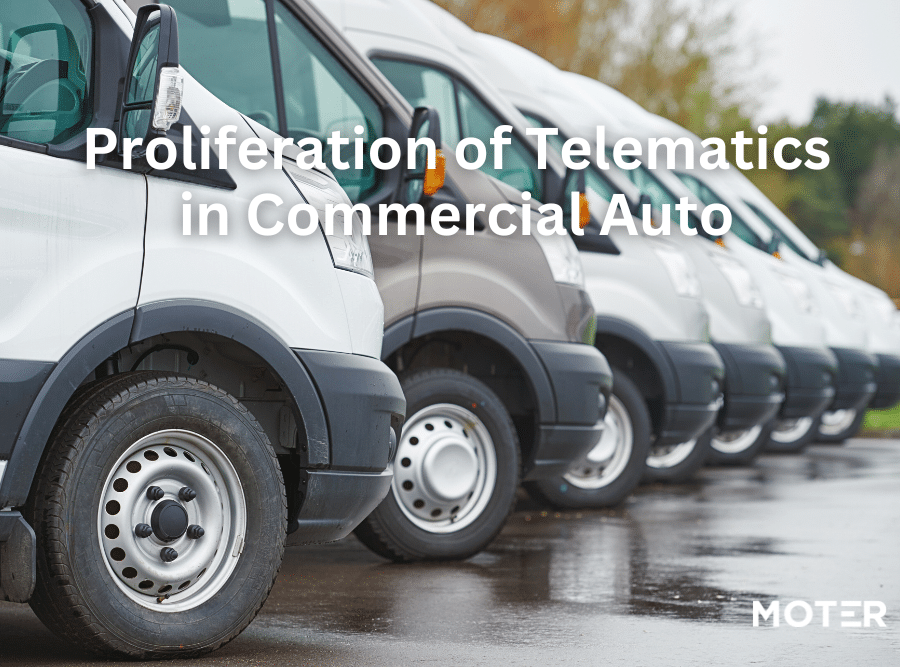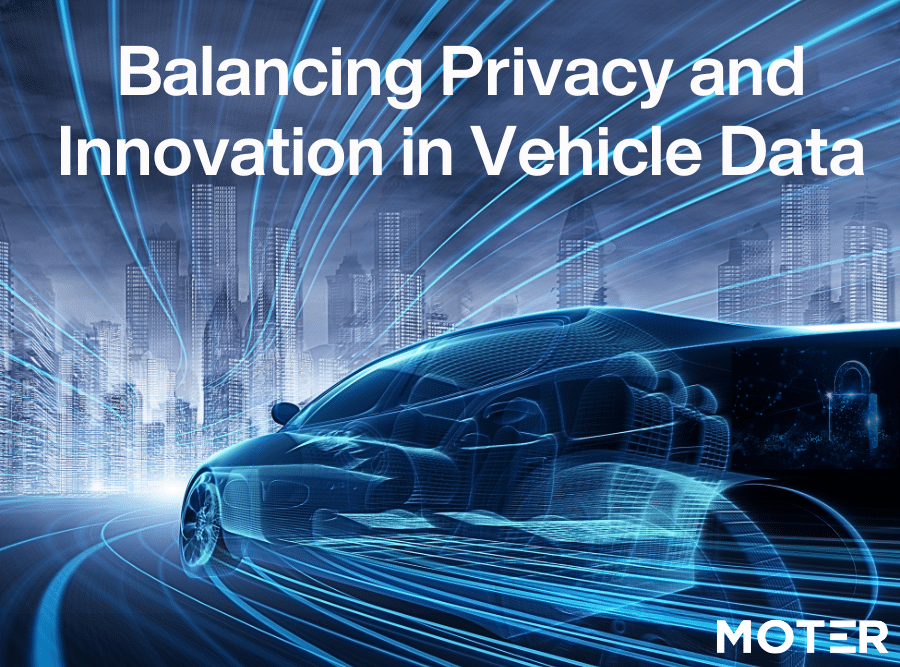Background
Connected Cars to Reach 99% Penetration by 2030
Smart car trends show that nearly all new vehicles will be connected to the cloud, infrastructure and each other by the year 2030, representing a $250 billion market. Wards Intelligence estimates there will be upwards of 150 million connected vehicles in the U.S. alone by that time. This trend is gathering momentum as developers, OEMs, data service providers and government regulators work together to encourage and support the coming age of the connected car.
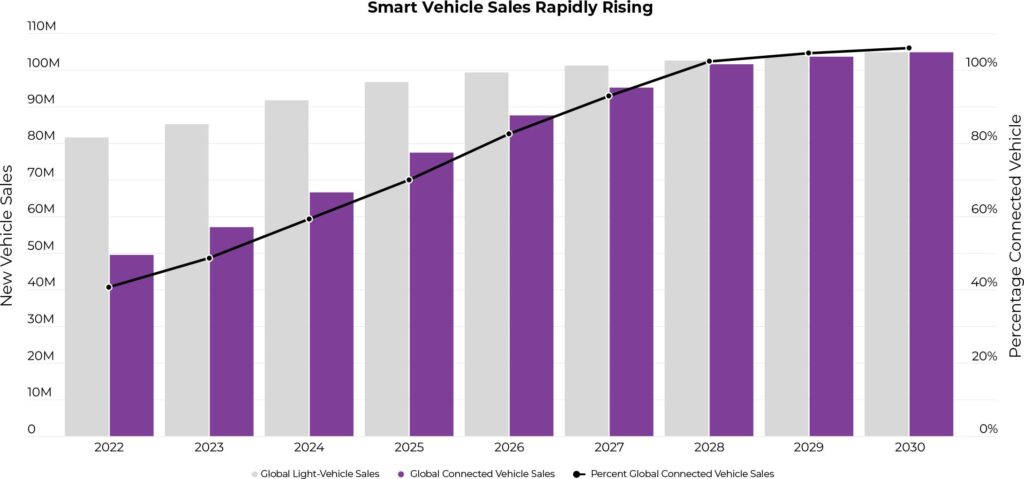
Connectedness and access to data from beyond the vehicle bring many advantages that enhance safety, convenience, autonomy and traffic flow. When a car can literally see the future through the “eyes” of vehicles and infrastructure ahead of it, traffic jams, obstacles, construction and road hazards can be avoided. This will save lives and time while reducing accidents.
The more useful information a vehicle collects, the more informed its decisions will be and the more value its insights can provide. This is especially important for safety systems, including driver assistance and autonomy technologies. Information collected also provides insight into driving behavior, as well as opportunities for coaching to help drivers develop safer habits.
Eventually, when most vehicles are connected and highly automated, they can coordinate movements to greatly improve traffic flows. Maintenance service also is improved through data sent to auto dealers from the vehicles.
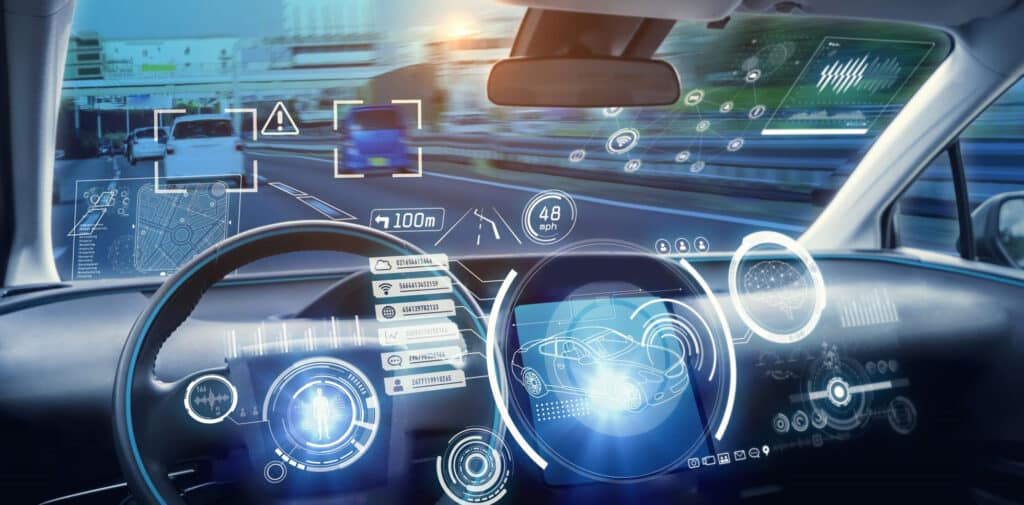
Massive Automotive Data Sets
These smart, connected vehicles produce massive amounts of data, up to 1 terabyte per vehicle per day or more. External sensors, cabin sensors and feedback from the vehicle itself form a constant torrent of information.
OEMs are transitioning to new centralized computing platforms to deal with this flood of data and to make software development, maintenance and updates easier. Data from multiple types of sensors surrounding the vehicle are “fused” to produce a 360-degree model of the external environment. These data then are fed to the AI system to track its position, and the position of other vehicles, pedestrians and objects around it, so the vehicle can plot a safe course through this gauntlet to its destination.
Vehicle data includes rate of acceleration, vehicle speed, and steering and braking actions that paint a picture of how the driver is interacting with the vehicle and its surroundings. In the future, interactions with other connected vehicles and infrastructure will join the data mix.
Missing Piece in the Data Ecosystem
Automakers desire to monetize connected car data but are not doing it effectively today. Insurers want to utilize connected car data but currently are unable to do so efficiently or at scale.
This is the result of a large gap in the data ecosystem, and it raises many questions. What happens to all this data the vehicle collects? Does it just sit in vehicle memory until it is overwritten by new data? Can it be uploaded to the cloud and sent to the OEM?
How can OEMs capitalize on this valuable information? Who else can benefit from access to this data? Could OEMs even deal with the petabytes of data and the data transfer charges from numerous vehicles? Can the data be analyzed at the edge and prepackaged to reduce bandwidth and provide useful information? How can this gap be bridged?
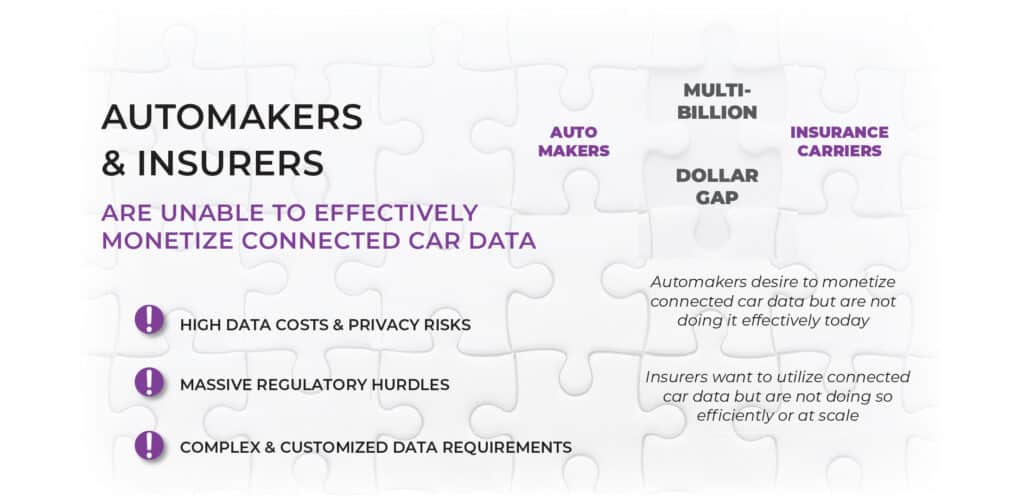
Bridging the Gap with Driver Data
Data Science Software Platform
These questions illustrate the challenge facing the smart car ecosystem: what to do with valuable vehicle data and how to make it more useful so it can be monetized. What is needed is a new platform that uses data science to collect relevant data from multiple sensor sources, then process and analyze it to produce useful and concise insights to third parties.
This platform should bridge the gap between automotive and other ecosystems that can benefit from vehicle and driver data by sifting through mountains of data to glean pertinent and actionable information for clients.
Edge-to-Cloud Software, Hardware-Agnostic
To be widely useful and portable, the platform should run on the edge, with a connection to the cloud, and be hardware-agnostic. This will ensure the broadest application across vehicle architectures. That combination of edge processing and cloud connectivity produces maximum benefit to end users and maximum monetization for OEMs. Embedded data science software running on the edge should be able to work with multiple operating systems and sensor suites, and in various geographic regions.
Data collected can be leveraged from connected vehicles and sensors such as cameras to evaluate driving behavior, location, usage and more. This is enabled by edge computing software that runs on the vehicle itself to analyze enormous amounts of data while minimizing data transmission and analysis costs by only transmitting actionable insights to customers. Such a cloud-based platform can be updated over the air (OTA) for optimal performance, security and accuracy.
Connecting Insurance Companies with Data from Automakers
OEMs can benefit from such a platform by realizing cost-effective commercialization of connected car data. Deep data science provides insights into risks, safety and performance to a broad ecosystem of data customers, including fleet operators. This data relationship enables the opportunity for long-term customer engagement and revenues. Vehicle owners can benefit from a lower total cost of ownership.
One of the largest target sectors for this data is the automotive insurance industry. Insurers will benefit from a number of aspects, including a broader dataset to better evaluate risk and drivers, advanced analytics to improve pricing and underwriting, and deep data science insights to reduce accidents and improve the claims experience.
This also opens up new features such as access to the latest benefits from computer vision, ADAS and new sensor data, collaboration with connected car data providers, and new customer acquisition opportunities.

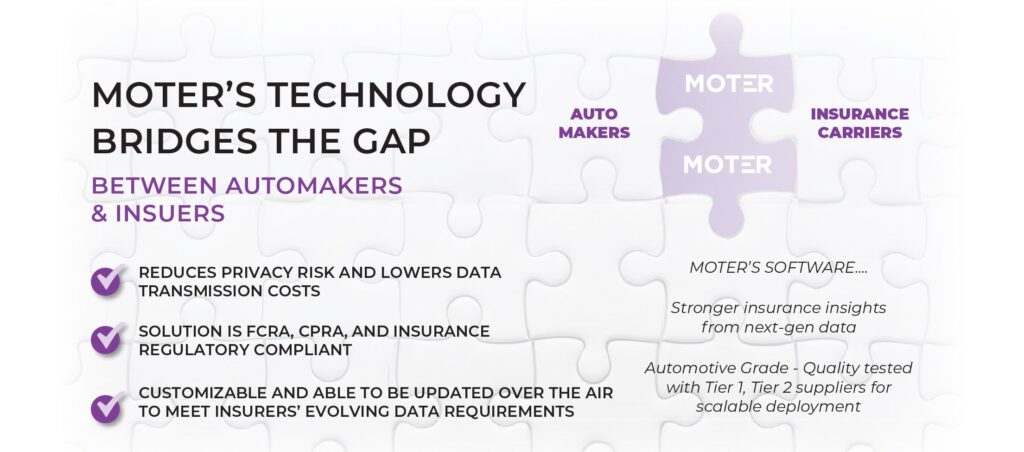
Market Potential for Automakers
Leveraging and Monetizing Vehicle Data
Such a platform unlocks and interprets vehicle data for direct use in the insurance business, and makes data monetization with insurers highly profitable, providing recurring revenue by leveraging and monetizing valuable vehicle data. This platform also should mitigate privacy risks by keeping most individual driver data on the vehicle itself.
Edge Analysis Reduces Data Costs
Edge processing and analysis enables a highly efficient way to gather, process and analyze massive data sets to produce concise insights. This dramatically reduces data transfer costs up to 90% by transmitting only the pertinent insights that provide actionable intel for insurance providers. This reduces costs for OEMs which can pass those savings along to customers.
Value Proposition for Insurers
Driver Data to Evaluate Risk and Score Drivers
These insights measure driving behavior within the context of the vehicle’s environment. Such a system can evaluate risk and even price insurance in real time. Driver risk intelligence helps insurers gauge the risk of potential customers before underwriting that risk.
Analytics to Improve Pricing
Risk monitoring helps insurers continuously monitor and assess customer risk to support insurance pricing. Collision analytics bring the ability to evaluate damage in crash assessment, identify which parties are at fault and allocate liability among parties.
Having complete data enables expedited claims filing, handling and servicing to streamline the process and virtually remove guesswork.
Customer Acquisition
The close and ongoing relationship with the insured provides insurers with a sales channel of highly qualified leads for additional products.
Putting It All Together: The MOTER Platform
About MOTER
Let’s take a look at how MOTER Technologies is filling this gap in the data ecosystem to provide revenue to OEMs and insights to insurers in the automotive sector. Founded in April 2021, and based in Los Angeles, California, MOTER is a subsidiary of Aioi Nissay Dowa Insurance, part of the MS&AD Insurance Group.
MOTER is P&C licensed in most states in the U.S. and the MOTER platform is built on years of knowledge from both the insurance and automotive industries to empower insurers and automakers to increase the bottom line and improve results. MS&AD is ranked as the eighth largest insurance and financial services group in the world, No.1 in the ASEAN region and has operations in 49 countries and regions worldwide.
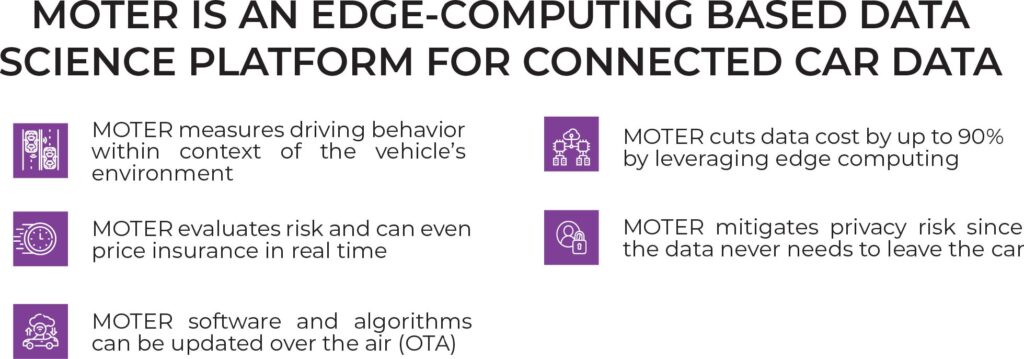
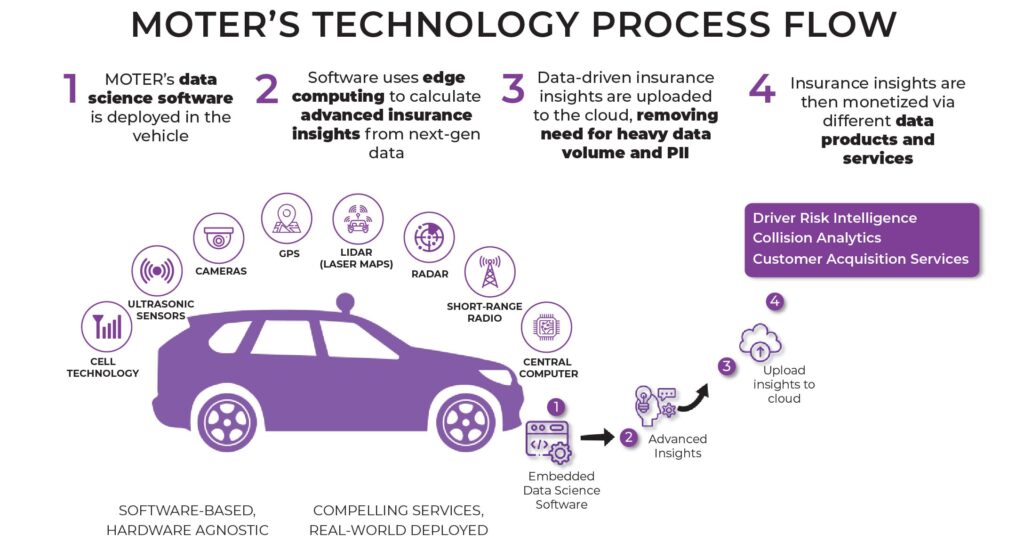
Embedded Software Collects Data
MOTER’s data science software is deployed in the vehicle in the form of embedded software that runs on the vehicle’s system. Risky events such as speeding, tailgating and ignoring traffic signs are collected in real time. A key use case is MaaS (Mobility-as-a-Service) such as car sharing, ridesharing, delivery and vehicle subscriptions.
Edge Computing Produces Insights
MOTER provides a versatile platform utilizing flexible edge-computing software connected to the cloud and can be installed in any vehicle architecture. This software gathers data from in vehicle sensors and uses edge computing to calculate advanced insurance insights from this next-generation data.
Insights Uploaded to Cloud
The insights consist of information that is distilled from large data sets into concise intel that is then uploaded to the cloud, removing the need for heavy data volume and personally identifiable information. This creates a unique and highly valuable product that can be sold to automotive insurance providers.
Insurance Insights are Monetized by Automakers
These insights are received by automakers and then monetized through different data products and services to the automotive insurance sector. This system enables higher adoption rates by insurance carriers and lower operational costs, providing higher returns from recurring revenue opportunities.
Insurance Companies and their Customers Benefit from Data Insights
This insight provides insurance companies with intelligence about driver risk to gauge driving behavior to help evaluate risk and price insurance in real time. In the event of a collision, MOTER provides analytics to evaluate damage and who was at fault. The MOTER web portal provides access to a wealth of information, including trip summaries, videos and driver scores. This complete system is an end-to-end solution with compelling benefits for insurers, automakers and their customers.
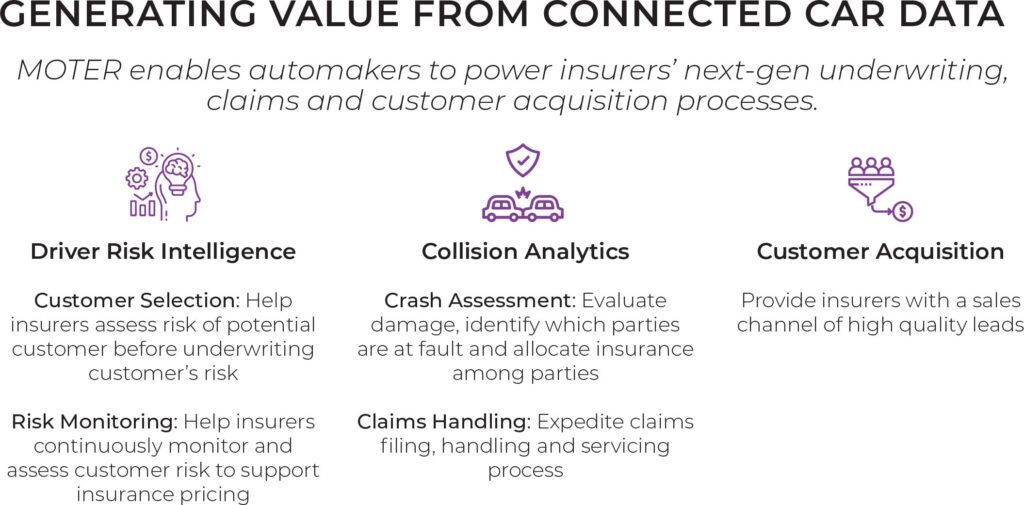
For More Information
MOTER Technologies | 21061 S. Western Ave, Ste 200 Torrance, CA 90501
Visit the MOTER website at www.moter.ai or via email at info@moter.ai

